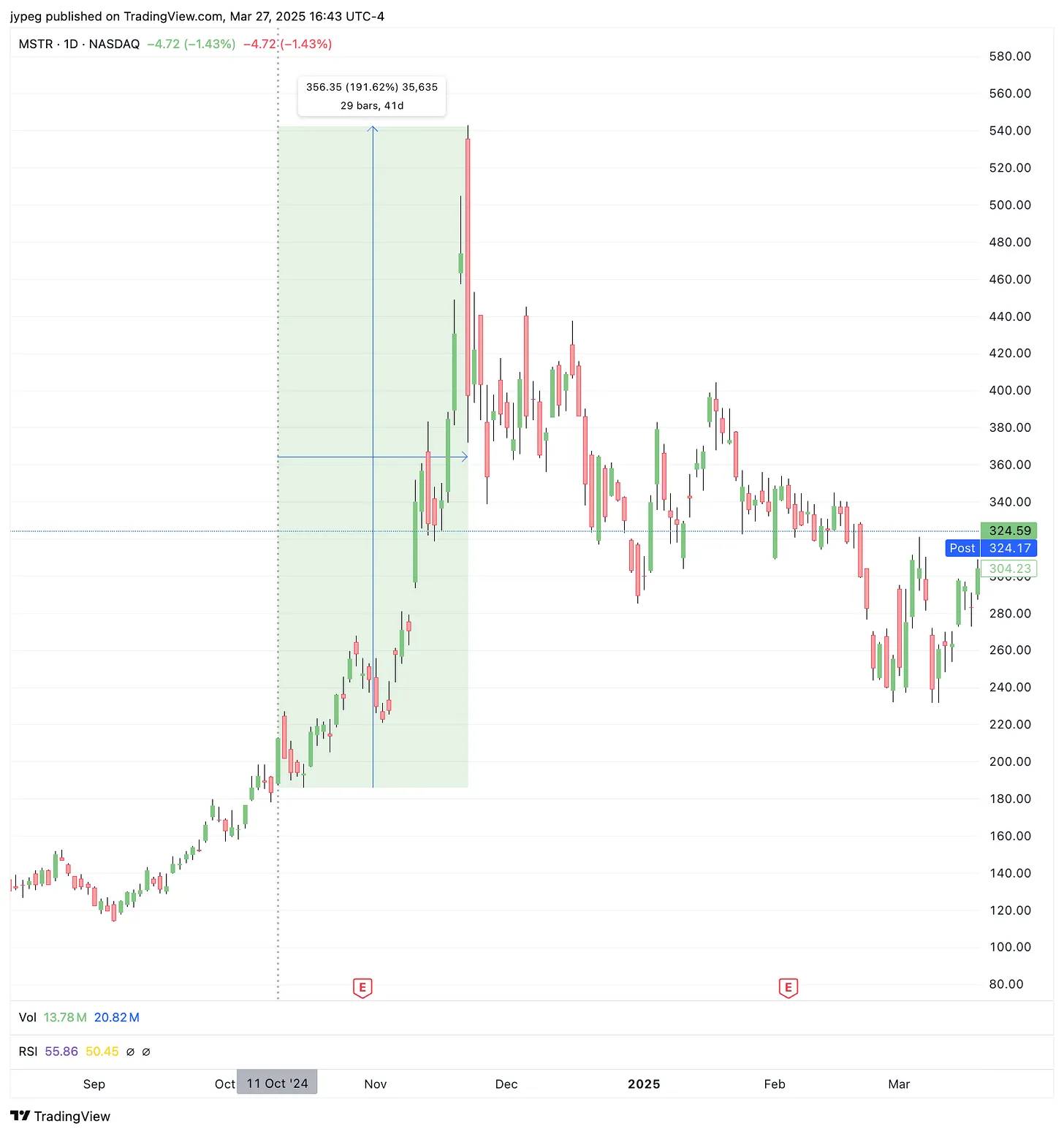Author: JAY
Translation: Deep Tide TechFlow
Since October 2024, the stock price of Strategy (MSTR) has experienced dramatic fluctuations. It soared from $188 to $540, achieving nearly a threefold increase, but then fell back and stabilized in the low range of $300.
Behind this stock price trend are a series of significant initiatives driven by the company's founder, Michael Saylor, including renaming the company to Strategy, purchasing over 506,000 bitcoins (BTC), and issuing two new preferred stocks, STRK and STRF.
However, there are many inaccurate interpretations in the market regarding how Strategy operates. To help investors more clearly assess whether Saylor's bitcoin reserve strategy is sustainable, we attempt to simplify its core logic.

Saylor's Bitcoin Reserve Strategy: Two Core Points
Saylor's financial strategy can be summarized in the following two points:
Selling Stock Options for Immediate Gains
Strategy sells purchase or conversion options for MSTR stock, setting the exercise price in the range of 30% to 300% of the current stock price, and collects all proceeds in advance through structured transactions. This is mainly achieved by issuing convertible bonds and preferred stocks STRK and STRF.
Issuing Additional Stock at the Right Time
Using the ATM (At-the-Market) mechanism, additional MSTR stock is issued when market conditions are favorable to further raise funds.
It is important to note that Saylor has not explicitly planned to repay the principal of these options or bonds. His core goal is to maintain the long-term operation of the financing plan while paying interest until the stock price of MSTR rises to the relevant exercise price.
The core advantage of this strategy lies in its highly flexible financing approach. By utilizing this strategy, Saylor can choose the best fundraising tools based on market conditions:
- Issue convertible bonds when implied volatility is high;
- Issue additional stock through the ATM mechanism when the net asset value (NAV) of MSTR stock is at a premium;
- If neither of the above conditions is met, issue more preferred stock (such as STRK or STRF).
There may be concerns about the high leverage risk of this strategy, but data indicates that such concerns are unfounded. Here are the key financial data for MSTR:
- Market capitalization: $85 billion;
- Bitcoin holdings market value: approximately $44 billion (506,000 BTC);
- Total debt: $8.2 billion, with an annual interest rate of only 0.421%, resulting in annual interest expenses of about $34 million;
- Preferred stock dividend expenses: $58.4 million annually for STRK and $85 million annually for STRF.
Through ratio analysis of this data, it can be seen that Saylor's use of leverage is actually very limited, and the cost of debt is extremely low.
Bitcoin Reserve Strategy vs. Traditional Banking Model
The bitcoin reserve strategy of Strategy can be compared to the operational model of traditional banks to some extent. The core operational logic of both is as follows:
Traditional Banking Model
Banks amplify leverage through a fractional reserve system to increase returns, but this model can occasionally lead to bank failures.
- Accept customer deposits;
- Use deposit funds to purchase "safe" government-backed debt (such as treasury bonds, mortgage-backed securities, etc.);
- Pay depositors interest that is lower than the returns on debt investments.
Bitcoin Reserve Strategy
Unlike traditional banks, Strategy's bitcoin reserve strategy does not use excessive leverage, as the government will not provide similar bailouts for issues that arise.
- Raise funds (similar to banks accepting deposits);
- Use the raised funds to purchase bitcoin (rather than government-backed debt);
- Pay investors returns on MSTR stock and periodic interest or dividends.
Despite the different operational methods, the core goal of both models is to achieve profitability through fund management. Banks rely on the net interest margin (the difference between the returns on debt investments and the interest on deposits), allowing investors to benefit from a portion of the debt interest passed through the bank. In contrast, bitcoin reserve companies rely on the capital appreciation of bitcoin, allowing investors to benefit from the volatility of bitcoin prices (more detailed information can be referenced to understand how this trading works and why this model is advantageous for convertible bond buyers). This appreciation mainly comes from the rise in bitcoin prices or the depreciation of the dollar relative to bitcoin.
Future Potential of the Bitcoin Reserve Strategy
Michael Saylor is one of the most ardent advocates of the bitcoin reserve strategy. His asset management model has successfully attracted many companies to follow suit and has prompted the U.S. government to begin exploring similar reserve strategies. The continued rise in MSTR and bitcoin prices has become the best "advertisement" for this strategy, further promoting market recognition of the bitcoin reserve concept.
Although currently only a few truly understand and accept Saylor's strategy, as bitcoin and MSTR develop, the market influence and sustainability of this strategy are strengthening. Market attention and feedback, in turn, drive the success of the strategy, and this "reflexivity" may bring longer-term development potential to the bitcoin reserve strategy.
免责声明:本文章仅代表作者个人观点,不代表本平台的立场和观点。本文章仅供信息分享,不构成对任何人的任何投资建议。用户与作者之间的任何争议,与本平台无关。如网页中刊载的文章或图片涉及侵权,请提供相关的权利证明和身份证明发送邮件到support@aicoin.com,本平台相关工作人员将会进行核查。




